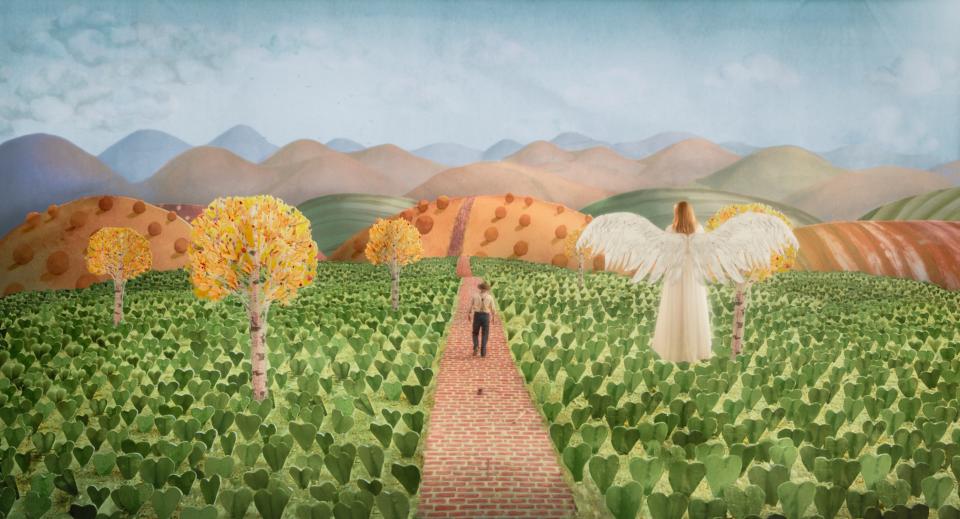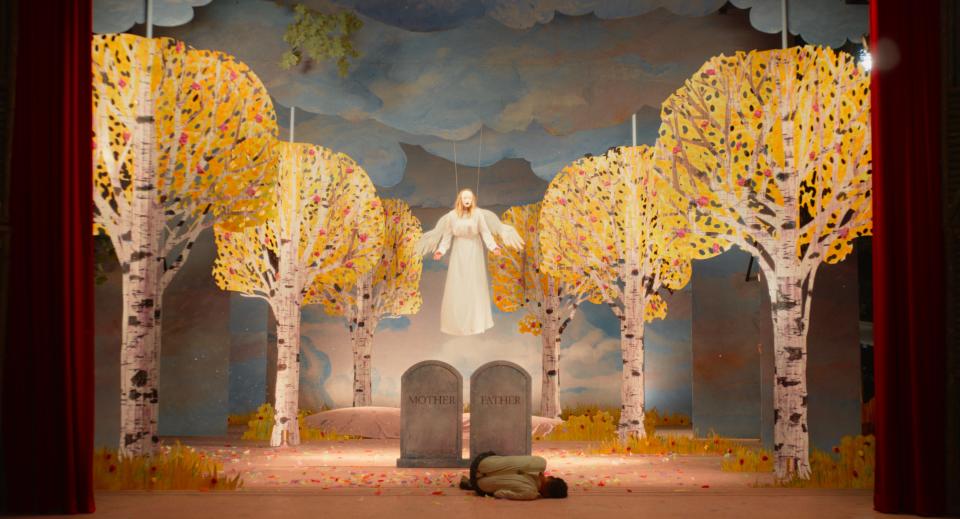Ari Aster Turns ‘Beau Is Afraid’ Upside Down in the Animated ‘Hero Beau’ Sequence

Late in Ari Aster’s subversive Oedipal odyssey, “Beau Is Afraid,” Joaquin Phoenix’s neurotic man-child enters a play in the woods as a momentary escape from his nightmarish existence. The 12-minute, predominantly stop-motion sequence — aptly titled “Hero Beau” — joyfully conjures an alternate reality of what might have been for Beau, free of his castrating mother (Zoe Lister-Jones and Patti LuPone), raising three boys on a farm, surviving a disaster, and living a full life.
Directed by Chilean animators Cristóbal León and Joaquín Cociña (“La Casa Lobo”), this movie-within-the-movie is exquisitely hand-crafted with the aid of some set design by production designer Fiona Crombie (“The Favourite”), evoking an unnatural world that’s as symbolically dreamlike as the rest of the film. It serves as Beau’s emotional high point and provides the impetus for the rest of his actions thereafter.
More from IndieWire
How Apple TV+'s Animated 'Frog and Toad' Series Retains and Expands the Original Books' Charms
Genndy Tartakovsky Goes Steampunk in New Adult Swim 'Unicorn Warriors: Eternal' Series
“The original plan was not for it to be animated but for it to be strictly stagecraft,” Aster told IndieWire. “He enters a world that’s all flat and very artificial sets that are revolving around him and moving. Then I think we became nervous about how much we could actually build with the resources and time. So I decided, ‘Let’s do half that and half animation.’ So it’s animated elements interacting with these artificial, stagey environments.
“Then the question became which animation house do we go to. I had seen ‘La Casa Lobo,’ this Chilean film made by Cristobal Leon and Joaquin Cociña. I was really blown away. It’s really a miraculous, frightening piece of work. You could trace what they were doing back to artists like [Jan] Švankmajer or [Ladislas] Starevich. But at the same time, this wasn’t like anything, it was just totally personal and unique.”
Aster produced their short film, “Los Huesos,” and spoke to them about working on “Beau Is Afraid. “I wasn’t sure if they’d ever want to do something like this. I figured they’d bristle at the idea of taking direction because they are artists and make their own work. But I loved them, they were so sweet.”

Courtesy of A24
Coordinating the animation, though, proved quite challenging. The producers tapped Jorge Cañada Escorihuela, a VFX supervisor (“The Crown”), to serve as animation producer. He helped plan the practical shoot with sets and green screen, created the workflow, which involved shot listing and storyboarding, and then assembled several hundred assets from León and Cociña that were composited as plates with the aid of post-production visualization (postvis).
“This was huge, very long, very difficult to figure out the approach of how to do it,” Escorihuela told IndieWire. “Because mainly what Ari wanted is just to get this kind of handmade look. [Karel] Zeman, who did ‘The Fabulous Baron Munchausen,’ was our main inspiration. He used to play with miniatures in the right perspective and distance to the camera to make the sets feel huge but also manageable. The job was how to make it look as if it would have been built? Also, part of the animation ideas were to paint characters or animals on top of the actual footage [Rotoscoping], or to stop-motion animate certain elements, like a house popping up, or silhouette to get a collage of elements that would help thinking about painting and volumetric as two different dimensions.”

Courtesy of A24
Aster called it a “very kaleidoscopic sequence” that needed to be cohesive and yet fit the aesthetics of the rest of the film. “It meant there was a lot of tinkering with it,” the director added. “There were these great sequences they’d send in, these beautiful animated elements that were just not quite functioning in harmony with the rest of the movie. It was a long road to get to something that just felt, at least to me, like it fit and wasn’t just clashing. Jorge kept it all on track, as it was so complicated and needed constant attention/management while we were toiling away on the rest of the film.”
Stop-motion was the primary technique (both 2D and volumetric), using different materials and applications. This included paintings on large canvases and then photographed at 12 fps, models sculpted and destroyed and then edited backwards, and paper flowers and trees that grew through time-lapse photography.
“Then, in order to have a few dimensions of reality, we had to erase the barriers of the volumetric and the pictorial,” Escorihuela said. “By mixing all these materials and techniques, throughout the journey of our hero, it is really hard to judge what is real and what isn’t, but also in which dimension we are in when looking at each section and element. That certainly helps to understand the confusion of this world reinforcing the feeling of [Beau].”
Additional reporting by Eric Kohn.
Best of IndieWire
Martin Scorsese's Favorite Movies: 60 Films the Director Wants You to See
Quentin Tarantino's Favorite Movies: 53 Films the Director Wants You to See
Sign up for Indiewire's Newsletter. For the latest news, follow us on Facebook, Twitter, and Instagram.

 Yahoo News
Yahoo News 

